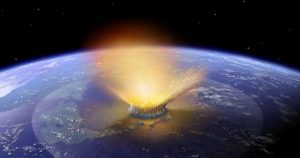4 minutes, 46 seconds
Barely time to change a light bulb—the difference between life and death for millions on July 13, 2029
The closing velocity of an incoming asteroid is about 12.6 km per second, and if it were to cross the Earth’s orbit, a “near-miss” distance in thousands of kilometers would translate into a mere few minutes from impact. The 2004MN4 could have caused a catastrophe that would make the Asian Tsunami seem like a walk in the park. This isn’t pie-in-the-sky doomsday-type speculation but documented scientific fact.

At 12.6 km a second, distances in 1000’s kilometers close very quickly
As tracking proceeded, the figures fluctuated slightly, and the closest astronomers predicted the asteroid 2004MN4 would miss our planet by a mere 3,380 km, or 0.53 Earth radii (“worst-case” inner edge of the predicted eclipse). In more frightening terms, the asteroid would be less than five minutes away!
What astronomers now find alarming is that the MN4, now appropriately dubbed Apophis, will be passing so close to Earth that our gravitational pull may effect the asteroid’s orbital path, making its return flyby path in 2036 unpredictable.
Much like the proposed and bureaucratically stalled Indian Ocean tsunami early-warning system that would have saved untold thousands of lives, astronomers in NEO research face the same lack of pre-disaster support, despite growing and ample evidence. One reason is that the authorities have a tough enough time balancing budgets without extending taxpayer funds to hunt for long-odds objects in space … no matter how short those odds seem to get.
Shorter than five minutes??? How closely must these objects pass before this phenomena is red flagged???
So when a ‘near miss’ is reported in hundreds of thousands of kilometres, it is also in reality, if it were on a trajectory with Earth, only hours away from collision. Compare for instance the speed of a shooting star to that of a commercial jet’s flashing lights in the night sky, and you will get an idea of the velocity asteroids travel at.
More on how asteroids are tracked and documented is explained on the Spaceguard website.




